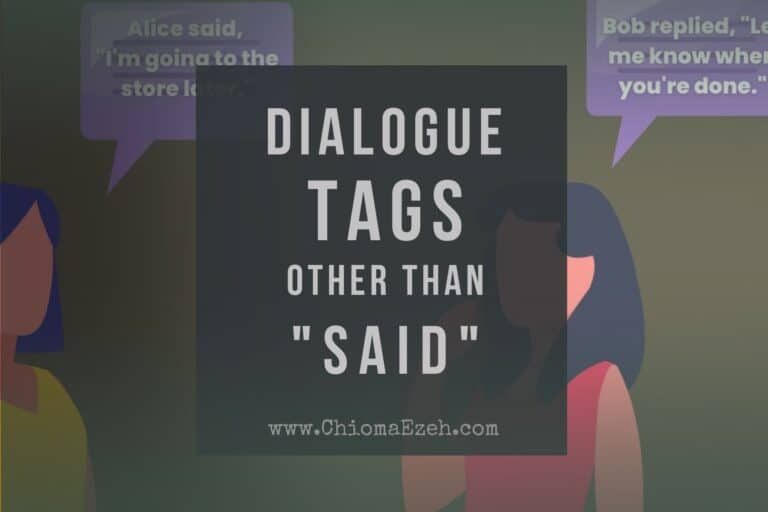How Does Dialogue Affect A Story? [Here’s how]
If you’re reading this, you’re probably intrigued by the power of dialogue in storytelling. Have you ever wondered how words exchanged between characters can make or break a story? How does dialogue affect a story?
In this article, I’ll guide you through the fascinating world of dialogue and its impact on storytelling. So, grab your favorite beverage, sit back, and let’s dive in.
Let’s Talk
Are you a writer aspiring to pen a masterpiece that never fails to captivate? Look no further. Reach out to us and uncover how we can help you to take your writing to unprecedented heights!

How Does Dialogue Affect A Story?
We all know that dialogue is an essential aspect of any story. It’s the lifeblood that connects characters, propels the plot, and conveys emotions. Dialogue can make us laugh, cry, and even change our lives. Dialogue affects the entire story in three broad ways:
- Affects the characters (reveals characters)
- Affects the Plot (advances the plot, creates plot twists, provides exposition, pace, theme, atmosphere)
- Engages Readers (tension and suspense)
1. Affects the Characters
Dialogue is a fantastic tool for showing, not telling. Remember the age-old adage, “actions speak louder than words”? Well, dialogue is the exception. Through dialogue, characters reveal their personalities, quirks, and motivations.
Think of a memorable line from your favorite book or movie, like when Sherlock Holmes says, “Elementary, my dear Watson.” This line, though never actually written by Sir Arthur Conan Doyle, perfectly captures Holmes’ brilliant yet dismissive nature.
2. Affects the Plot
Dialogue propels the story forward by revealing critical information, triggering events, or raising the stakes. Remember that pivotal scene in “The Godfather” when Michael Corleone says, “I’ll make him an offer he can’t refuse”? This iconic line signals a turning point in the story and sets the stage for Michael’s rise to power.
3. Affects The Reader
In real life, people bond through conversations. The same holds true for characters in a story. Dialogue allows them to forge connections, develop trust, or spark rivalries.
A great example is Elizabeth Bennet and Mr. Darcy’s witty banter in “Pride and Prejudice.” Their initial disdain for each other blossoms into love, thanks in part to their engaging verbal sparring.
How Does Dialogue Affect the Character?
Dialogue is an essential tool for bringing your characters to life, revealing their personalities, emotions, and motivations. By crafting authentic and engaging dialogue, you can create multi-dimensional characters that captivate your readers.
1. Reveals Personality Traits
Characters’ speech patterns can offer valuable insights into their personalities. For example, a character who uses formal language and elaborate vocabulary might be well-educated or pretentious, while a character who employs slang and colloquialisms could be more laid-back and relatable.
Example: Dr. Thompson: “I must vehemently disagree with your assessment, Mr. Johnson.” Ricky: “Chill out, Doc. We’re just havin’ a chat.”
2. Showcases Emotions
Dialogue can also convey a character’s emotions, making readers empathize with their feelings. A heartfelt confession, an angry outburst, or a sarcastic remark can reveal the character’s emotional state and make them more relatable to the reader.
Example: Samantha (crying): “I can’t take it anymore! I feel so lost and alone.” Daniel (gently): “I’m here for you, Sam. You don’t have to face this by yourself.”
3. Unveils Hidden Agendas
Characters can use dialogue to manipulate others, advance their own interests, or conceal their true intentions, creating tension and intrigue.
Example: Lady Tremaine: “Cinderella, dear, I only want what’s best for you. Trust me, the ball is no place for a simple girl like you.” Cinderella: “But, stepmother, I dream of going to the ball. Why won’t you let me?” Lady Tremaine: “You’ll thank me one day, my dear.”
3. Builds Relationships
In real life, people bond through conversations. The same holds true for characters in a story. Dialogue allows them to forge connections, develop trust, or spark rivalries. A great example is Elizabeth Bennet and Mr. Darcy’s witty banter in “Pride and Prejudice.” Their initial disdain for each other blossoms into love, thanks in part to their engaging verbal sparring.
How Dialogue Advances the Plot
Well-crafted dialogue can propel your story forward by introducing new information, creating turning points, or raising the stakes. By using dialogue to advance the plot, you keep the reader engaged and eager to know what happens next.
1. Reveal Critical Information (exposition)
Characters can share crucial information through dialogue, either intentionally or inadvertently. This information can change the course of the story and create new challenges or opportunities for the characters.
Example: Detective Baker: “The lab results came back. The poison used in the murder is extremely rare and can only be obtained from one supplier in the city.” Officer Carter: “That narrows down our list of suspects significantly.”
2. Reveals Conflict
Characters can engage in heated arguments that expose underlying conflicts, reveal contrasting viewpoints, or escalate existing issues.
Example: Anna: “You always put your work before our family, Jack! I can’t take it anymore.” Jack: “I’m doing this for us, Anna! I’m trying to provide for our future.”
Dialogue can have a significant impact on the reader in various ways, helping to create an engaging and immersive experience. Here are some key ways dialogue affects the reader:
3. Creates Turning Points (Plot twists)
Dialogue can also lead to turning points in your story, where the characters make important decisions, face new obstacles, or experience revelations.
Example: Emily: “I’ve decided to accept the job offer in Paris. It’s time for me to start a new chapter in my life.” David: “But what about us, Emily? What does this mean for our relationship?”
4. Slow Or Speed Up the Pace
Dialogue can speed up or slow down a story’s pace. Rapid, back-and-forth exchanges create a sense of urgency and excitement, while longer, introspective conversations allow for contemplation and reflection.
Fast-paced example: Alice: “The bomb’s ticking!” Bob: “How much time?” Alice: “Two minutes!” Bob: “We need to defuse it, now!”
Slower-paced example: Alice: “I can’t believe it’s been five years since we last saw each other.” Bob: “Time flies, doesn’t it? So much has changed.”
5. Affects The Theme
Dialogue can have a significant impact on a story’s theme, helping to reinforce, clarify, or explore the central ideas and concepts within the narrative. Characters’ conversations can help to emphasize the story’s theme, driving home its importance to the reader.
Through subtext, dialogue can hint at underlying themes without explicitly stating them, allowing the reader to engage with the story more deeply.
6. Establishes Tone and Atmosphere
How characters speak to each other reflects the story’s tone and atmosphere. Consider the terse, gritty dialogue in Raymond Chandler’s hardboiled detective stories. It sets a distinct mood and transports the reader to the seedy underbelly of 1940s Los Angeles.
Having seen how broadly dialogue affects the story, let’s get down specifically to each of them
How Does Dialogue Affect the Reader?
Dialogue can evoke emotions in your readers, making them laugh, cry, or feel a sense of suspense. Engaging dialogue fosters a strong emotional connection with the reader, making them more invested in the story.
1. Builds Tension and Suspense
Dialogue can create suspense by introducing new information, hinting at potential dangers, or revealing character motivations. Suspense keeps the reader engaged, as they become eager to know what happens next.
Example:
Captain Black: “There’s a storm brewing on the horizon, and I’ve got a bad feeling about it.”
First Mate Grey: “Should we turn back, Captain?”
Captain Black: “No, we press on. But be prepared for anything.”
The conversation between First Mate Grey and Captain Black builds anticipation and leaves the reader wondering what happens next.
2. Creates Emotional Connection:
Dialogue can evoke emotions in the reader, such as happiness, sadness, anger, or fear. By crafting authentic and relatable conversations, you can create an emotional bond between your characters and your readers, which makes them more invested in the story.
Example: Sophie (tearfully): “I never thought I’d see you again, Ethan. I missed you so much.” Ethan: “I missed you too, Sophie. I promise I’ll never leave you again.”
This emotional exchange tugs at the reader’s heartstrings, making them feel empathy and compassion for the characters.
3. Showcases Character Relationships:
Dialogue allows readers to understand the dynamics between characters, such as friendships, rivalries, or romances. By crafting engaging and believable interactions, you can make the reader care about these relationships and their development throughout the story.
Example: Lily: “You always have my back, Alex. I don’t know what I’d do without you.”
Alex: “That’s what friends are for, Lily. I’ll always be here for you, no matter what.”
This heartfelt conversation highlights the strong bond between Lily and Alex, making the reader invested in their friendship.
4. Creates Humor
Witty banter, clever wordplay, or humorous misunderstandings can lighten the mood and make readers laugh. Humor can make the story more enjoyable, as well as create a balance between tension and relief.
Example: Jake: “Have you ever tried eating a clock?” Mia: “No, why would I do that?” Jake: “Well, I did once. It’s very time-consuming!”
This lighthearted joke shared between Jake and Mia brings a smile to the reader’s face and adds a touch of levity to the story.
Video Recommendation: How Does Dialogue Affect a Story?
Final Notes: How Does Dialogue Affect A Story?
Dialogue is a versatile and powerful tool that can greatly impact your story by affecting characters, advancing the plot, engaging the reader, and creating tension. You can craft immersive and compelling narratives that leave your readers eager for more.
Remember, the key to great dialogue is authenticity, creativity, and a touch of magic. So, embrace the challenge, experiment with different techniques, and let your characters’ voices shine.



![Types of Audiences In Writing [Explained]](https://chiomaezeh.com/wp-content/uploads/2023/02/Types-of-audiences-in-writing-768x512.jpg)

![5 Easy Ways To Write Dialogue For A Novel [Template + Example]](https://chiomaezeh.com/wp-content/uploads/2023/03/how-to-write-dialogue-for-a-book-2-768x512.jpg)
